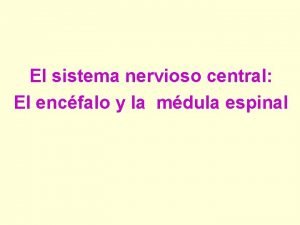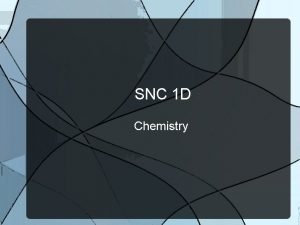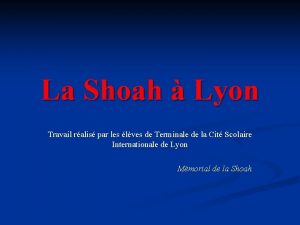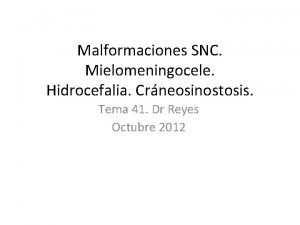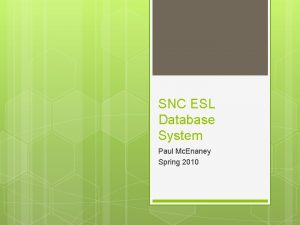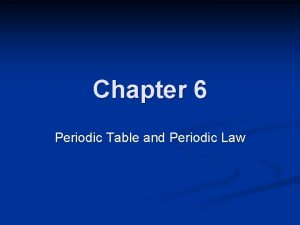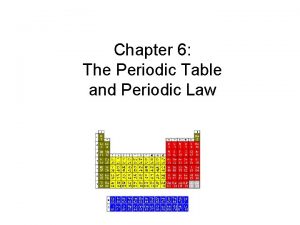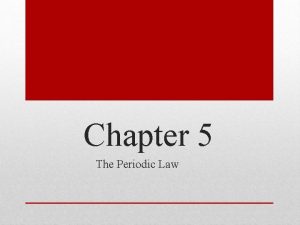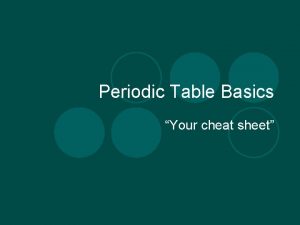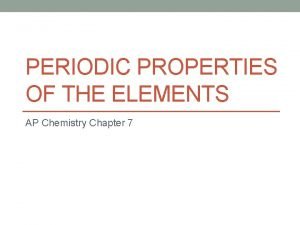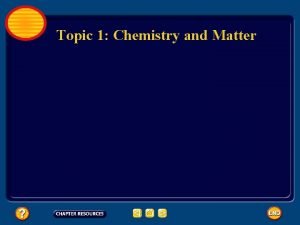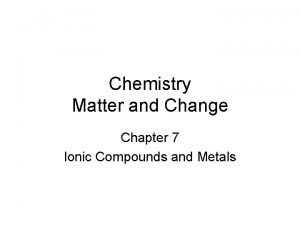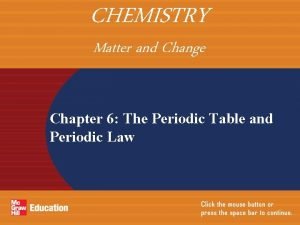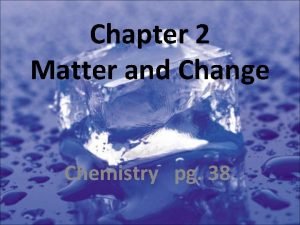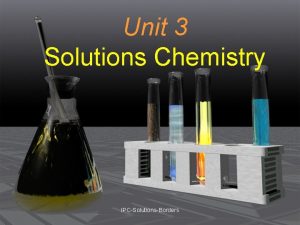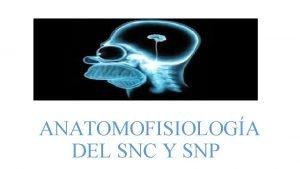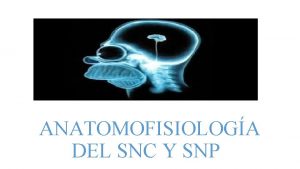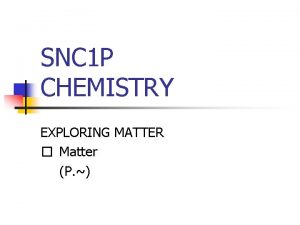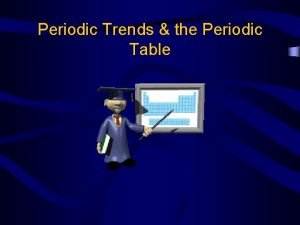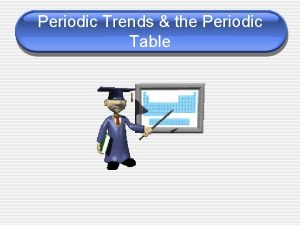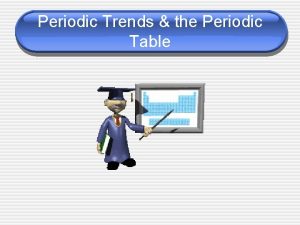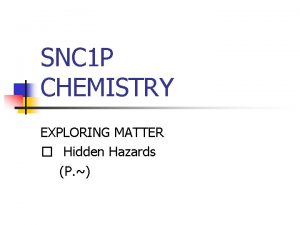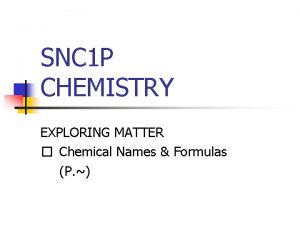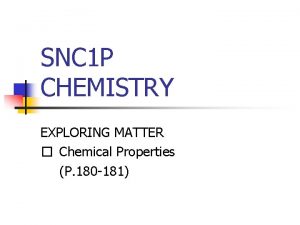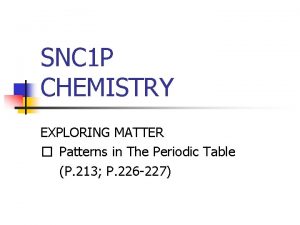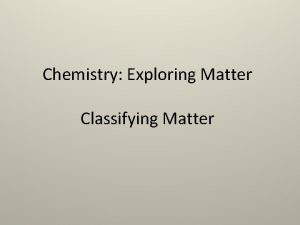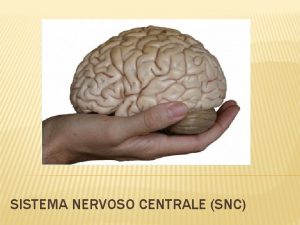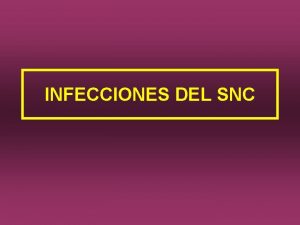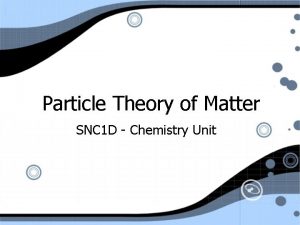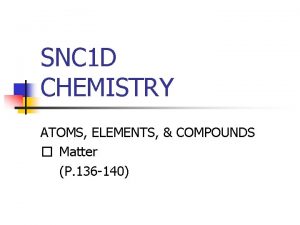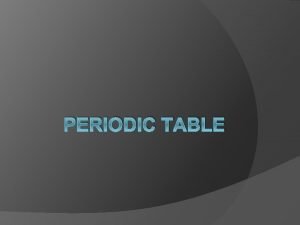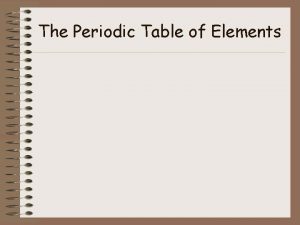SNC 1 P CHEMISTRY EXPLORING MATTER The Periodic




































- Slides: 36

SNC 1 P CHEMISTRY EXPLORING MATTER � The Periodic Table (P. 212)

The Early Periodic Table By the 1780 s, chemists wondered why some elements, such as oxygen, were gases, while others, such as gold, were metals. To complicate matters, by the 1860 s, the list of known elements had grown to 63. No one knew if that list included all the elements that existed or whethere were hundreds or even thousands more that were still undiscovered. Many chemists continued to search for a unifying pattern among the elements. January 31, 2022 1 PCHEM - The Periodic Table 1

The Early Periodic Table In 1867, Russian scientist Dmitri Mendeleev found the pattern. He did it by gathering all the information that he could about the known elements and writing it down on cards, using one element per card. The information included properties such as estimates of the mass of the atoms of each element, colour, density, melting point, and what each element did or did not react with. January 31, 2022 1 PCHEM - The Periodic Table 2

The Early Periodic Table He then arranged the cards in order of increasing mass, sorting the cards into rows and columns, based on similarities in the elements’ properties. This arrangement of cards formed a table. Within Mendeleev’s table, and for the first time in history, a complete pattern of the elements emerged. His early periodic table made the study of chemistry manageable! January 31, 2022 1 PCHEM - The Periodic Table 3

The Early Periodic Table In Mendeleev’s table, all the cards representing metals ended up on one side, and all the non-metals ended up on the other. Metalloids were in the middle. Even most of the elements that were gases at room temperature were grouped together. When Mendeleev did not find an element with the right properties to put in a column, he left a gap – the gap represented an element that was yet to be discovered. January 31, 2022 1 PCHEM - The Periodic Table 4

The Early Periodic Table Mendeleev had so much confidence in his arrangement that he boldly predicted the physical and chemical properties of the elements that would occupy each gap. Doubters were convinced when new elements, such as gallium (Ga) and germanium (Ge), were discovered several years later with properties almost exactly as Mendeleev had predicted. January 31, 2022 1 PCHEM - The Periodic Table 5

Activity: Solving a Puzzle BACKGROUND Mendeleev’s first attempt at arranging elements into a table was much like trying to put together a puzzle that was missing pieces. In this activity, you will try to assemble the pieces of a puzzle to help you identify the properties of the missing piece. MATERIALS Handouts of puzzles A. A January 31, 2022 1 PCHEM - The Periodic Table 6

Activity: Solving a Puzzle INSTRUCTIONS A. Puzzle A shows 19 pieces from an original set of 20. A single piece is missing. Your mission is to arrange the 19 pieces into rows and columns according to their properties, identifying as many trends as you can. B. When all the pieces are in place, the missing piece will become obvious to you, just as the missing elements were clear to Mendeleev. Sketch the missing piece, showing all its properties. January 31, 2022 1 PCHEM - The Periodic Table 7

The Modern Periodic Table Today we use a table based on Mendeleev’s table. In the modern periodic table (P. 214 and 215), elements are listed from left to right and top to bottom according to a property called atomic number. January 31, 2022 1 PCHEM - The Periodic Table 8

The Modern Periodic Table Each element has its own square on the periodic table. The information given in the square is not always the same on different versions of the periodic table, but the element’s name, symbol, and atomic number are almost always given. The square to the right shows two other pieces of information: atomic mass and ion charge. January 31, 2022 1 PCHEM - The Periodic Table 9

The Modern Periodic Table NOTE! The first letter of every chemical symbol is a capital letter (i. e. N for nitrogen). If there is a second letter, it is always lowercase (i. e. Fe for iron). The rules for capitalization are very important – Co stands for the element cobalt whereas CO represents the poisonous compound carbon monoxide. January 31, 2022 1 PCHEM - The Periodic Table 10

The Modern Periodic Table – Atomic Number Atomic number is the number of protons in an atom of an element. The first element, hydrogen (H), has atomic number 1. This means that every hydrogen atom has one proton in its nucleus. The next element in the periodic table is helium (He), which has atomic number 2. All helium atoms have two protons. This increase continues through the entire table. January 31, 2022 1 PCHEM - The Periodic Table 11

The Modern Periodic Table – Atomic Number ATOMIC NUMBER v the number of protons in an atom of an element v different for every element January 31, 2022 1 PCHEM - The Periodic Table 12

The Modern Periodic Table – Atomic Number PRACTICE (Use the periodic table in the back of your text) 1. Find the atomic number of each of the following elements: 6 (a) C 8 (b) O 11 (c) Na 14 (d) Si 16 (e) S January 31, 2022 1 PCHEM - The Periodic Table 13

The Modern Periodic Table – Atomic Number PRACTICE (Use the periodic table in the back of your text) 2. How many protons are in atom of each of the following elements? 3 (a) lithium 7 (b) nitrogen 9 (c) fluorine 13 (d) aluminum 29 (e) copper January 31, 2022 1 PCHEM - The Periodic Table 14

The Modern Periodic Table – Atomic Number PRACTICE (Use the periodic table in the back of your text) 3. Name the element with following number of protons. hydrogen (a) 1 helium (b) 2 neon (c) 10 potassium (d) 19 calcium (e) 20 January 31, 2022 1 PCHEM - The Periodic Table 15

The Modern Periodic Table – Atomic Mass Atomic mass is the average mass of an element’s atoms. Atomic mass is given in atomic mass units (amu). From the diagram we see that iron has an atomic mass of 55. 85 amu. From the periodic table, we see that the atomic mass of hydrogen is 1. 01 amu. This means that iron atoms are about 55. 85 times heavier than hydrogen atoms. January 31, 2022 1 PCHEM - The Periodic Table 16

The Modern Periodic Table – Atomic Mass NOTE! Atomic masses are always expressed as decimal fractions. One reason for this is that, except for fluorine, atoms of the same element have different numbers of neutrons. As a result, atoms of the same element with different numbers of neutrons have different masses. January 31, 2022 1 PCHEM - The Periodic Table 17

The Modern Periodic Table – Atomic Mass ATOMIC MASS (amu) v the average mass of an element’s atoms January 31, 2022 1 PCHEM - The Periodic Table 18

The Modern Periodic Table – Atomic Mass PRACTICE (Use the periodic table in the back of your text) 4. Find the atomic mass for each of the following elements. 1. 01 amu (a) H 4. 00 amu (b) He 14. 01 amu (c) N 19. 00 amu (d) F 40. 08 amu (e) Ca January 31, 2022 1 PCHEM - The Periodic Table 19

The Modern Periodic Table – Atomic Mass PRACTICE (Use the periodic table in the back of your text) 5. Name the element with the following atomic mass. carbon (a) 12. 01 amu oxygen (b) 16. 00 amu potassium (c) 39. 10 amu krypton (d) 83. 80 amu iodine (e) 126. 90 amu January 31, 2022 1 PCHEM - The Periodic Table 20

The Modern Periodic Table – Ion Charge Ion charge is the electric charge that an atom takes on when it loses or gains electrons. An atom (or group of atoms) that has gained or lost electrons is called an ion. When this happens, one of two types of ions results – a positively charged ion, or cation, or a negatively charged ion, or anion. January 31, 2022 1 PCHEM - The Periodic Table 21

The Modern Periodic Table – Ion Charge NOTE! Elements that can form similar ions are grouped together in the periodic table. Metals generally lose electrons and become positive ions. Many non-metals can gain electrons and so become negative ions. Some elements, like helium, do not form ions. For these elements, no ion charges are shown in their squares in the periodic table. January 31, 2022 1 PCHEM - The Periodic Table 22

The Modern Periodic Table – Ion Charge ION CHARGE v electric charge an atom takes on when it loses or gains electrons v loses electrons � + ve ion (cation) v gains electrons � – ve ion (anion) January 31, 2022 1 PCHEM - The Periodic Table 23

The Modern Periodic Table – Ion Charge PRACTICE (Use the periodic table in the back of your text) 6. What is the electric charge on an ion of each of the following elements? (a) Li 1+ (b) Be 2+ (c) N 3(d) S 2(e) Al 3+ January 31, 2022 1 PCHEM - The Periodic Table 24

The Modern Periodic Table – Ion Charge PRACTICE (Use the periodic table in the back of your text) 7. Although the element hydrogen is a non-metal, it is located on the left side of the periodic table. Explain how placing hydrogen in this position relates to its ion charge. hydrogen only has one electron January 31, 2022 1 PCHEM - The Periodic Table 25

The Modern … – Standard Atomic Notation We can represent the numbers of subatomic particles by using standard atomic notation, an internationally recognized system used to communicate information about an atom. Using this notation, we write the chemical symbol of the atom and place the atomic number to the lower left and the mass number to the upper left. STANDARD ATOMIC NOTATION A = atomic mass Z = atomic number X = chemical symbol NOTE! = # p’s + # n’s = # p’s # e’s = # p’s = Z (since atoms are electrically neutral) # n’s = A – Z January 31, 2022 1 PCHEM - The Periodic Table 26

The Modern … – Standard Atomic Notation PRACTICE 8. Express the following elements using standard atomic notation. �Hydrogen �Carbon �Magnesium �Sulphur �Potassium January 31, 2022 1 PCHEM - The Periodic Table 27

The Modern … – Standard Atomic Notation PRACTICE 9. How many electrons, protons, and neutrons are there in the following atoms? 4 2 He 16 8 O 28 14 Si 31 15 P 40 20 Ca 70 31 Ga 75 33 As #p 2 8 14 15 20 31 33 #e 2 8 14 15 20 31 33 #n 2 8 14 16 20 39 42 January 31, 2022 1 PCHEM - The Periodic Table 28

The Modern Periodic Table Each horizontal row in the periodic table is called a period. A number written on the left side of the table identifies each period. The properties of elements that are in the same period can be very different. January 31, 2022 1 PCHEM - The Periodic Table 29

The Modern Periodic Table Each vertical column in the periodic table represents a different group or chemical family. Each group has its own number, written at the top of the table. Elements in the same group have similar properties – including the same number of electrons in their outmost orbit. January 31, 2022 1 PCHEM - The Periodic Table 30

The Modern Periodic Table Most elements are either metals (green box) or non-metals (gold box). They are separated by a dark line that looks like a staircase. Hydrogen is the only exception. Elements along the staircase – the metalloids (purple box) – have properties in between those of metals and non-metals. January 31, 2022 1 PCHEM - The Periodic Table 31

The Modern Periodic Table MODERN PERIODIC TABLE v based on table created by Dmitri Mendeleev v helps to explain/predict physical and chemical properties v elements are arranged in order of atomic number (# of protons) v table organized into 7 rows (periods) and 18 columns (groups) v elements in same group (chemical family) have similar chemical/physical properties v metals – left and centre; non-metals – right; metalloids – in between NOTE! Hydrogen is located in the metals but it behaves as a non-metal. January 31, 2022 1 PCHEM - The Periodic Table 32

The Modern Periodic Table PRACTICE (Use the periodic table in the back of your text) 10. Give the names and symbols for the elements found at these locations. sodium Na (a) Period 3, Group 1 boron B (b) Period 2, Group 13 copper Cu (c) Period 4, Group 11 iodine I (d) Period 5, Group 17 January 31, 2022 1 PCHEM - The Periodic Table 33

The Modern Periodic Table PRACTICE (Use the periodic table in the back of your text) 11. Give the period and group for each of the following elements. 3, 2 (a) Mg 3, 14 (b) Si 3, 17 (c) Cl 1, 18 (d) He 6, 11 (e) Au January 31, 2022 1 PCHEM - The Periodic Table 34

�Check Your Learning TEXTBOOK P. 217 Q. 5, 6, 11 WIKI (CHEMISTRY) �. . 1 PCHEM - WS 2 (The Periodic Table) January 31, 2022 1 PCHEM - The Periodic Table 35
 Skeleton hand whmis
Skeleton hand whmis Snc y snp diferencias
Snc y snp diferencias Snc1d chemistry
Snc1d chemistry Snc lajaa venissieux
Snc lajaa venissieux Snc società
Snc società Snc
Snc Snc database
Snc database 6 the periodic table
6 the periodic table Periodic trebds
Periodic trebds Periodic family names
Periodic family names The periodic table and periodic law chapter 6
The periodic table and periodic law chapter 6 Chapter 5 periodic law
Chapter 5 periodic law Section 1 composition of matter
Section 1 composition of matter Grey matter reliaquest
Grey matter reliaquest Composition of matter section 1
Composition of matter section 1 Chapter 2 section 1 classifying matter answer key
Chapter 2 section 1 classifying matter answer key Median and lateral apertures
Median and lateral apertures Classification of matter section 1 composition of matter
Classification of matter section 1 composition of matter Gray matter and white matter
Gray matter and white matter What is gray matter in the brain
What is gray matter in the brain Flow energy review
Flow energy review Valence electron cheat sheet
Valence electron cheat sheet Ap chemistry chapter 7 periodic properties of the elements
Ap chemistry chapter 7 periodic properties of the elements Definition of substance
Definition of substance Chemistry matter and change chapter 7
Chemistry matter and change chapter 7 Chemistry: matter and change chapter 10 the mole answer key
Chemistry: matter and change chapter 10 the mole answer key Examples of matter in chemistry
Examples of matter in chemistry Classifying matter flow chart
Classifying matter flow chart Chemistry matter and change chapter 7
Chemistry matter and change chapter 7 Chemistry matter and change chapter 6
Chemistry matter and change chapter 6 Chemistry matter and change chapter 10 the mole answer key
Chemistry matter and change chapter 10 the mole answer key Chemistry matter and change chapter 2 answer key
Chemistry matter and change chapter 2 answer key Matter flowchart chemistry
Matter flowchart chemistry Graphic organizer matter classifications
Graphic organizer matter classifications Non examples of homogeneous mixture
Non examples of homogeneous mixture Chapter 4 basic food chemistry the nature of matter
Chapter 4 basic food chemistry the nature of matter Foods that are heterogeneous mixtures
Foods that are heterogeneous mixtures

